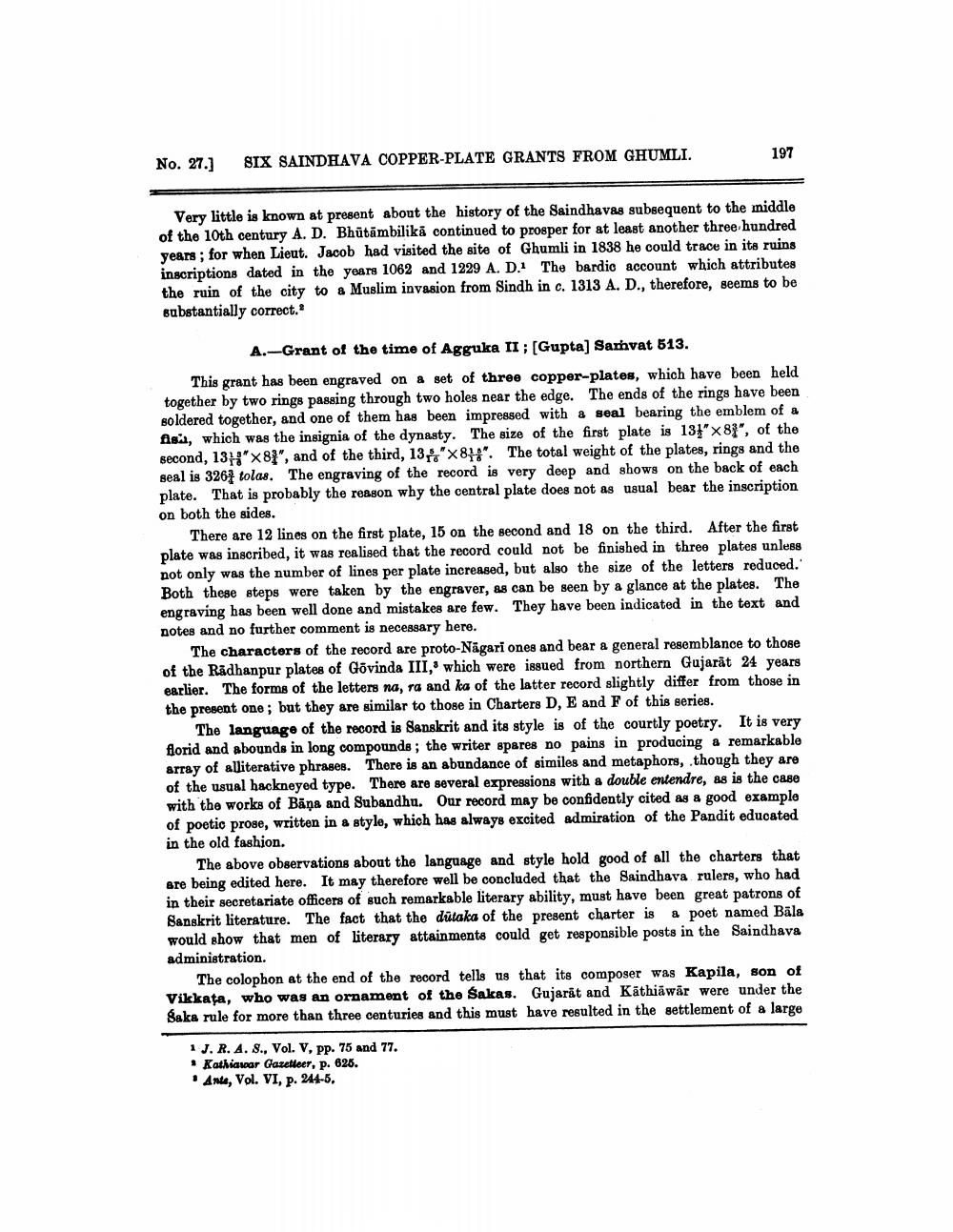________________
No. 27.]
SIX SAINDHAVA COPPER-PLATE GRANTS FROM GHUMLI.
197
Very little is known at present about the history of the Saindhavas subsequent to the middle of the 10th century A. D. Bhūtāmbilikā continued to prosper for at least another three hundred years; for when Lieut. Jacob had visited the site of Ghumli in 1838 he could trace in its ruins inscriptions dated in the years 1062 and 1229 A. D. The bardic account which attributes the ruin of the city to a Muslim invasion from Sindh in o. 1313 A. D., therefore, seems to be substantially correct."
A.-Grant of the time of Agguka II ; [Gupta] Samvat 513. This grant has been engraved on a set of three copper-plates, which have been held together by two rings passing through two holes near the edge. The ends of the rings have been soldered together, and one of them has been impressed with a seal bearing the emblem of a fiss, which was the insignia of the dynasty. The size of the first plate is 134' x 83", of the second, 1311" X 81", and of the third, 13" X 818". The total weight of the plates, rings and the seal is 3264 tolas. The engraving of the record is very deep and shows on the back of each plate. That is probably the reason why the central plate does not as usual bear the inscription on both the sides.
There are 12 lines on the first plate, 15 on the second and 18 on the third. After the first plate was inscribed, it was realised that the record could not be finished in three plates unless not only was the number of lines per plate increased, but also the size of the letters reduced. Both these steps were taken by the engraver, as can be seen by a glance at the plates. The engraving has been well done and mistakes are few. They have been indicated in the text and notes and no further comment is necessary here.
The characters of the record are proto-Nāgari ones and bear a general resemblance to those of the Rādhanpur plates of Govinda III, which were issued from northern Gujarat 24 years earlier. The forms of the letters na, ra and ka of the latter record slightly differ from those in the present one; but they are similar to those in Charters D, E and F of this series.
The language of the record is Sanskrit and its style is of the courtly poetry. It is very florid and abounds in long compounds; the writer spares no pains in producing a remarkable array of alliterative phrases. There is an abundance of similes and metaphors, though they are of the usual hackneyed type. There are several expressions with a double entendre, as is the case with the works of Bäņa and Subandhu. Our record may be confidently cited as a good example of poetic prose, written in a style, which has always excited admiration of the Pandit educated in the old fashion.
The above observations about the language and style hold good of all the charters that are being edited here. It may therefore well be concluded that the Saindhava rulers, who had in their secretariate officers of such remarkable literary ability, must have been great patrons of Sanskrit literature. The fact that the dutaka of the present charter is a poet named Bāla would show that men of literary attainments could get responsible posts in the Saindhava administration.
The colophon at the end of the record tells us that its composer was Kapila, son of Vikkata, who was an ornament of the Sakas. Gujarat and Käthiāwār were under the Saka rule for more than three centuries and this must have resulted in the settlement of a large
1 J. R. A. 8., Vol. V, pp. 75 and 77. • Kathasar Gazetteer, p. 625. • Ante, Vol. VI, p. 244-5,




